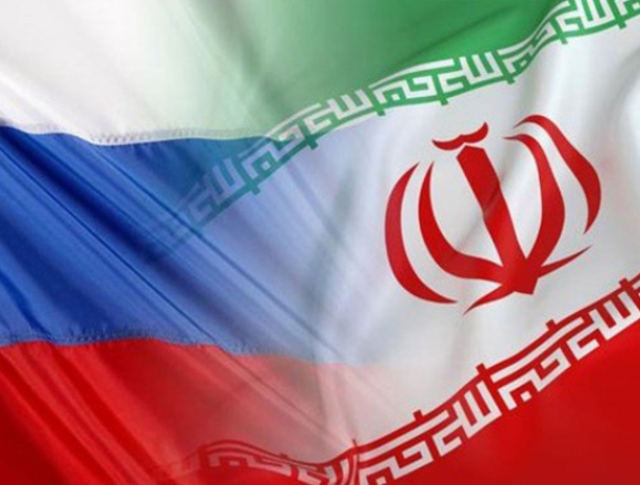TSAMTO, January 16. Deliveries of Russian Su-35 fighter jets to Iran are expected to begin in three months, Shahriyar Heydari, a member of the National Security and Foreign Policy Committee of the Iranian parliament, told the Iranian Tasnim news agency.
The parliamentarian clarified that deliveries of the first cars are expected at the beginning of next year according to the Iranian calendar (starting March 21).
In addition, as Heydari stressed, Tehran has ordered a number of other types of military equipment from Russia, including air defense systems, missile systems and helicopters, the deliveries of which will also begin in the near future.
It should be noted that this is the first confirmation by an official of Iran's purchase of the Su-35.
Reference on military-technical cooperation between Russia and IranIn connection with the first confirmation by an official of Iran's purchase of the Su-35, CAMTO publishes a brief historical background on cooperation between the two countries in the field of military-technical cooperation.
The first period of active military-technical cooperation between Russia and IranActive military-technical cooperation between Moscow and Tehran began in 1990.
In 1990, the USSR supplied VIVT to Iran from various sources in the amount of $733 million to $890 million.
In the field of armored vehicles, contacts between Russia and Iran have developed in the following areas.
Russia supplied about 120 BMP-2s to Iran between 1993 and 1997. (in total, in the period from 1993 to 2005, about 500 BMP-2s were delivered to Iran), as well as 800 ATGM 9M111 for BMP-2 in 1993.
In 1993-1996, 122 MBT T-72M1 were delivered. Of these, 100 MBTs were delivered in 1993, 20 in 1994 and 2 in 1996. The agreement on licensed production of the T-72 MBT in Iran has been implemented. The last deliveries of armored vehicles date back to 1998. Iran officially announced that it imported from Russia in 1998 four T-72 tanks, three BMP-2s, two 140-mm artillery systems and two rocket launchers or missiles.
In 1991, the S-200VE air defense system and a batch of missiles for it were delivered to Iran.
The largest deliveries were made in the field of aviation equipment and naval equipment.
In 1990, 14 MiG-29 aircraft were delivered to Iran. The peak of aircraft deliveries occurred in 1991, when 12 Su-24 and 20 MiG-29/MiG-29UB were delivered. Another 6 MiG-29/MiG29UB were delivered in 1993-1994. In 1990-1991, aircraft missiles R-27R (350 units) and R-60 (576 units) were delivered to arm the MiG-29. Another 94 R-27R missiles for the MiG-29 were delivered in 1994.
Russia has supplied Iran with three 877ECM DPL projects for a total of $750 million. According to the UN Register, the first DPL was delivered in 1992, the second in 1993 and the third in 1996.
Russia's first "withdrawal" from the Iranian arms marketThe volume of trade between Russia and Iran was estimated in the first half of the 1990s at an average of $500 million per year.
However, on June 30, 1995, under pressure from the United States, the Gor-Chernomyrdin memorandum was signed, according to which Moscow pledged not to conclude new contracts for the supply of conventional weapons to Iran, and to complete the execution of already concluded contracts by the end of 1999. Prior to the signing of the memorandum, Russia's obligations to Iran were based on four intergovernmental agreements signed in 1989, 1990 and 1991. According to them, Moscow was supposed to supply Tehran with MiG-29, Su-24MK, project 877EKM DPL (including the construction of shore-based facilities for them), S-200VE air defense systems, as well as establish licensed production of T-72 tanks and BMP-2 infantry fighting vehicles.
Russia did not have time to fully implement the contracts already signed with Iran before the date specified in the memorandum – December 31, 1999. As a result, Russia received less than $2 billion. In addition, Russia was forced to refuse to supply Iran with spare parts for VIVT, which, according to Russian-Iranian agreements, it was supposed to supply until 2011.
Iran has repeatedly made it clear to Russia about its desire to restore bilateral military-technical cooperation. In particular, in 1998, Tehran officially informed Moscow of its desire to purchase in Russia eight divisions of S-300PMU1 air defense systems, 1000 Igla MANPADS, 25 Mi-17-1V military transport helicopters, eight Su-25 attack aircraft, as well as S-300VM anti-aircraft missile systems, Gamma-DE radar stations", "Casta-2E2" and other military equipment worth about $ 2 billion. However, the Russian-American agreement in force at that time did not allow Moscow to sign contracts for the sale of these weapons.
The second period of active military-technical cooperation between Russia and IranIn November 2000, Moscow officially notified the US administration of the refusal from December 1, 2000 of the commitments given in 1995 not to supply conventional weapons to Iran.
In 2001-2002, supplies of ammunition and spare parts for MiG-29 and Su-24MK aircraft in service with the Iranian Air Force began.
Russia's main supplies of VIVT to Iran in the period from 2000 to 2010.From 2000 to 2003, the Ulan-Ude Aircraft Factory (UUAZ) delivered 27 Mi-171 helicopters in a civilian version to Iran (5 Mi-171 in 2000, 21 in 2001-2002 and 1 in 2003). In 2001, Iran signed a new contract with Rosoboronexport for the purchase of 36 in 2002-2004 Mi-171Sh helicopters.
During the official visit of the Iranian Defense Minister to Moscow in October 2001, Russia and Iran signed an intergovernmental agreement on military-technical cooperation, which legally defined the framework for further cooperation in this area.
In February 2003, Kurganmashzavod received an order for the supply of a batch of infantry fighting vehicles, which was completed in 2004. According to reports, it was about the supply of about 300 BMP-2 to Iran in the amount of about $ 60 million.
This order for the BMP-2 did not exhaust Iran's needs for this type of armored vehicles. Earlier, there was talk of a possible purchase of up to 1000 BMP-2, so an additional order for these machines could follow from Iran, especially since serious technical problems arose during the operation of the domestic Borak BMP.
UUAZ delivered three new Su-25UBK attack aircraft to Iran in 2003. Initially, it was about the delivery of 12 machines, but the contract was signed for only three aircraft. In continuation of this theme, another contract was signed in 2005 for the supply of three Su-25UBT aircraft.
In 2004, UUAZ completed the delivery of 36 Mi-171Sh helicopters to Iran under a contract signed in 2001.
At the beginning of 2005, KVZ delivered three Mi-17 helicopters to Iran for the sanitary service.
KBP has fulfilled a small contract with Iran for the supply of guided artillery shells (UAS) "Krasnopol-M".
In December 2005, Russia and Iran signed a contract for the supply of Russian VIVT worth more than $1.4 billion. It was about the purchase of 29 Tor-M1 air defense systems in the amount of $ 700 million. In addition, an agreement was reached on the modernization of aviation equipment in service with the Iranian Air Force. According to unofficial data, the aviation part of the contract provided for the repair and modernization of 24 Su-24 (the cost is about $ 300 million). Russia also planned to supply patrol boats for the Iranian Navy.
Russia fully completed the delivery of 29 Tor-M1 anti-aircraft missile systems to Iran at the end of December 2006. The Tor-M1 air defense systems are deployed to cover the most important state and military facilities, primarily nuclear ones in Isfahan, Bushehr, Tehran and in the east of the country from air attack.
Tehran was supplied with 12 new towed Tor-M1T complexes on an automobile chassis (they were specially developed by the Almaz-Antey air defense concern for Iran) and 17 Tor-M1 on a GM-5955 tracked chassis, previously intended for the Greek option, which was not implemented. In February 2007, the delivery of 1.2 thousand 9M331 missiles and spare parts for these complexes to Iran was completed.
Russian Tor-M1 air defense systems have shown a high probability of hitting air targets in Iran. During the firing tests of the complexes, Iranian calculations prepared in Russia shot down all air targets that simulated air attack means.
According to officially unconfirmed reports, Rosoboronexport acted as an intermediary in the sale to Iran of 200 V-84MS tank engines (produced by Chelyabinsk Tractor Plant-Uraltrak) in the amount of $200 million for installation on Iranian Zulfikar main battle tanks (created on the basis of licensed Russian T-72S).
In 2007, a contract was signed to supply Iran with five divisions of the S-300PMU-1 air defense system consisting of 40 launchers worth about $ 800 million. During the negotiations with Iran, the possibility of supplying the Nebo, Kasta, Gamma and Polyana radar stations was also discussed. Iran has expressed interest in acquiring T-90S tanks.
In mid-December 2005, reports appeared in the Russian media with reference to a source in the FSVTS that Russia had also reached an agreement on the supply of the Pechora-2A air defense system to Iran.
During the exhibition "Idex-2005" Iran submitted an application for the purchase of a towed artillery gun "Nona-K" of 120 mm caliber.
Russia's second "withdrawal" from the Iranian arms marketThe President of Russia (at that time)
On September 22, 2010, Dmitry Medvedev signed a decree on measures to implement UN Security Council Resolution N1929 of June 9, 2010.
The decree provided for a ban on the use of the territory of Russia for the transit movement (including by air) of weapons to Iran, the export of weapons directly from the territory of the Russian Federation, as well as the transfer of weapons outside the country using ships and aircraft under the state flag of Russia.
The ban applied to almost all types of conventional weapons according to the classification of the UN Register – battle tanks, armored combat vehicles, large-caliber artillery systems, combat aircraft, combat helicopters, warships, missiles and missile systems, as well as spare parts and material support for this equipment. The ban applied, including to the S-300PMU-1 air defense system.
The decree of the President of the Russian Federation fully complied with paragraph 8 of Resolution No. 1929, adopted on June 9, 2010 by the UN Security Council, which imposed a ban on the sale of all seven categories of weapons to the Islamic Republic of Iran according to the classification of the UN Register.
With the signing by Dmitry Medvedev on September 22, 2010 of the decree on measures to implement UN Security Council Resolution No. 1929 of June 9, 2010, Russia has already "lost" the Iranian arms market for the second time.
Russia's losses as a result of the curtailment of the military-technical cooperation with Iran in accordance with UN Security Council Resolution No. 1929 of June 9, 2010TSAMTO estimates Russia's losses as a result of the curtailment of military-technical cooperation with Iran in the amount of $11 to $12 billion.
This volume includes both supplies under already signed contracts (before the embargo on the supply of arms to Tehran was imposed) and lost profits from the curtailment of programs on promising projects.
It should be noted that in 2001, Iran began implementing a 25-year program of rearmament of the country's armed forces, which provided mainly for the purchase of Russian-made military equipment, the total amount of funding of which is estimated at $ 25 billion. Russian manufacturers in the period 2000-2025 could count on at least half of this amount, that is, $ 11-12 billion.
What Russia delivered to Iran after the imposition of sanctions in 2010 (2010-2015)The only officially confirmed delivery is the transfer of the 1L222 Avtobaza radio intelligence station to Iran in October 2011.
As Konstantin Biryulin, deputy director of the Federal Customs Service, said at the time, "negotiations are underway with the Iranian side on the further supply of such equipment."
As K. Biryulin stressed, "we are constantly negotiating with Iran on the purchase of military equipment that does not fall under UN Security Council sanctions. These are defensive systems, in particular in this case we are talking about electronic warfare."
Russia's third return to the Iranian arms marketAs of the beginning of 2016, the settlement of the Iranian "nuclear problem" by diplomatic means led to the lifting of most of the previously imposed restrictions of the UN Security Council on trade with Tehran.
Nevertheless, restrictions in the field of military-technical cooperation remained.
In particular, restrictions on the supply of conventional weapons to Iran have not been lifted: tanks, armored combat vehicles, large-caliber artillery systems (from 100 mm and above), combat aircraft and helicopters, warships, missiles or missile systems. In accordance with the terms of the deal on Iran's nuclear program, the supply of these weapons to Tehran can only be carried out with the prior permission of the UN Security Council. These restrictions were in effect until October 18, 2020.
Taking into account the fact that the UN Security Council embargo on the supply of weapons classified as "offensive" to Iran was in effect for a period of about 5 years, the most promising direction of the military-technical cooperation of Russia and Iran in this interim period was the topic of air defense as a purely "defensive" weapons system.
The first real step towards restoring relations in the field of military-technical cooperation was the renegotiation of the contract for the supply of S-300PMU-1 air defense systems and the withdrawal of Tehran's claim against Russia for non-fulfillment of the previous contract on air defense systems. Thus, Russia has saved itself from possible penalties, since Iran filed a lawsuit against Rosoboronexport in the Geneva Arbitration Court on April 13, 2011 in the amount of $4 billion for refusing to supply S-300PMU-1 air defense systems.
The amount of the claim included the cost of the contract for the supply of the S-300PMU-1 air defense system, the preparation by the Iranians of the infrastructure for putting the complexes on combat duty and moral damage.
In addition, Tehran has also included in this amount penalties on contracts with the Russian Federation since 1995, when, as a result of the Gor-Chernomyrdin deal, the military-technical cooperation between the Russian Federation and Iran was frozen.
In 2016, Russia completed deliveries under a previously canceled contract for the supply to Tehran of five divisions of S-300PMU-1 air defense systems worth more than $ 800 million.
After the completion of this contract, cooperation on other long-range air defense systems became possible.
The second area of cooperation with Iran in the interim period was the subject of electronic warfare.
According to available data, in the period from 2015 to 2018. 4 Resonance-NE long-range detection radars (air defense radars) were delivered to Iran (the order amount was estimated to be about $200 million).
During the transition period, cooperation was carried out on a number of weapons systems that are classified as purely "defensive".
With the settlement of the situation under the Joint Comprehensive Plan of Action (JCPOA) on the Iranian nuclear program and taking into account the fact that the JCPOA is interconnected with UN Security Council Resolution No. 2231, which provided for the lifting of restrictions on the supply of weapons to Iran back in October 2020, we should expect another, already fourth, but already "full-fledged" (unlike from the third stage) Russia's return to the Iranian arms market.According to various sources, Tehran intends to purchase a large batch of Russian weapons, including 24 Su-35 fighter jets and two S-400 SAM batteries.
In addition, the issue of Russia's overhaul of the Iranian MiG-29 and Su-24K and retraining of Iranian pilots is being discussed. In general, negotiations are underway on the supply of weapons worth about $ 10 billion.





